
Home

Research

Publications

Downloads


Links

People

|
|
Movies
Topics:

Merger of two neutron stars (1.4 & 1.5 M☉, no spin: 3D density volume rendering)
|
Description: Animation of the coalescence of two neutron stars
with masses 1.4 and 1.5 M☉ (7 million SPH particles).
Options:
- density, 3D-rendering, annotated:
.mov (2.4 Mb)
- density, 3D-rendering, annotated::
.mov (80 Mb)
- Electron fraction (Ye), 3D-cut, annotated:
.mov (5.6 Mb)
|
Neutron star vs neutron star encounters
In the following, the term encounters refers to
both gravitational wave-driven binary mergers, and dynamical collisions
which may occur in dense environments such as globular clusters.
Much interesting work has recently been done in this direction,
for a review and a pointer to literature see, for example,
If you make use of the provided data, please make sure to read and cite
the following papers:
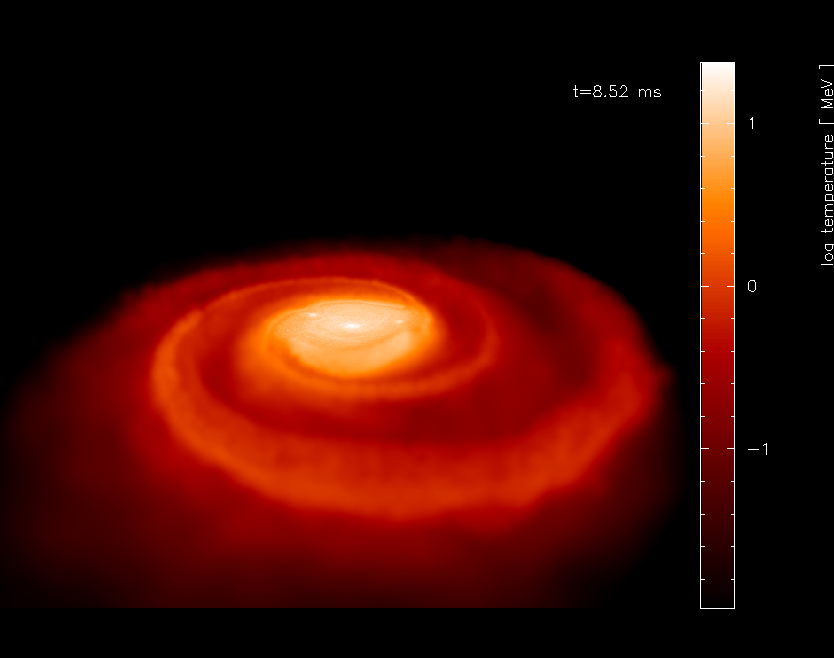
Merger of two neutron stars, no spin: 3D cut of the temperature
|
Description: Animation of the coalescence of two neutron stars
with masses 1.4 and 1.3 M☉, with no spin
(referred to as "run H" in Paper I,
see Table 1).
Considered the most likely case of a neutron star merger.
Options:
- Temperature, 3D-rendering, annotated:
.mov (23 Mb)
- Temperature, 3D-rendering, no annotation:
.mov (29 Mb)
- Temperature, 3D-cut, no annotation:
.mov (4.2 Mb)
- Electron fraction (Ye), 3D-cut, annotated:
.mov (14 Mb)
|

Merger of two corotating neutron stars: 3D-cut of the temperature
|
Description: Coalescence of two corotating neutron
stars with masses 1.4 and 1.3 M☉
(referred to as "run G" in Paper I, see Table 1).
This case is somewhat academic, since the neutron star viscosity is far too low
to lead to a tidal locking during neutron star inspiral.
Options:
- Temperature, 3D-cut, annotated:
.mov (23 Mb)
- Temperature, 3D-rendering, no annotation:
.mov (29 Mb)
- Temperature, 3D-rendering, annotated:
.mov (26 Mb)
- Density, 3D-cut, annotated:
.mov (3.5 Mb)
|
Dynamical collisions
For collisions presented below, only parabolic (marginally unbound) cases
were considered. The strength of a collision is characterized by the quantity
β≡ (r1 + r2) /rperi,
where the object radii ri refer in the black
hole cases to the Schwarzschild radii. See Paper I for more information.
Neutron star - neutron star collisions
For the double neutron star (ns2)-collisions presented below we
fix a slight mass asymetry (m1= 1.3 M☉,
m1= 1.4 M☉) and explore
the dependence on the impact strength parameter β.
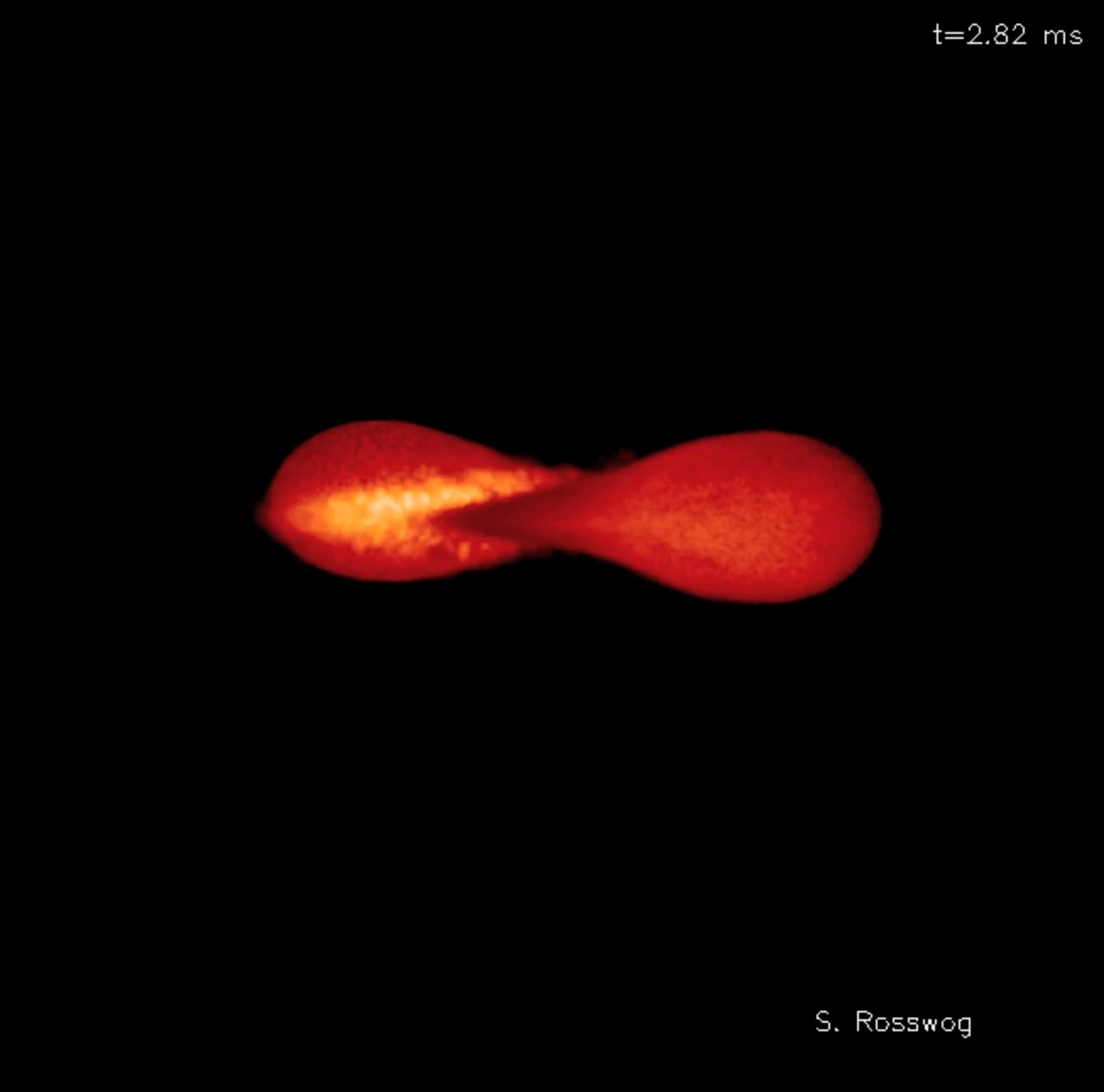
Grazing impact of two neutron stars with impact parameter β=1.
Movie shows 3D-rendering of the temperature distribution.
|
Description:
Animation of a neutron star - neutron star grazing impact.
Parameters: m1= 1.3 M☉,
m1= 1.4 M☉, β=1.
This simulation is referred to as "run A" in Paper I (see Table 1).
Link to download the movie:
.mov (2.4 Mb)
|
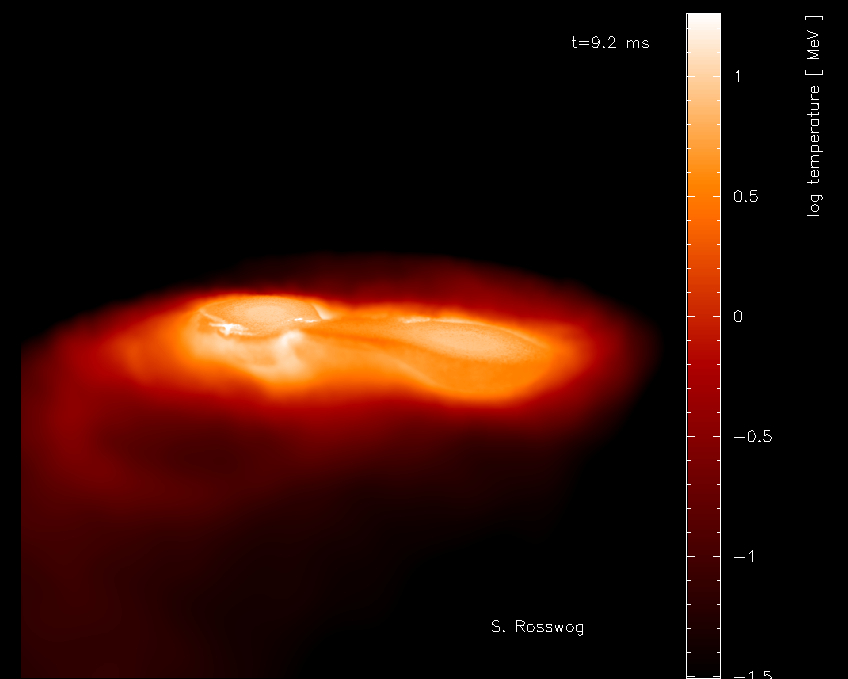
Grazing impact of two neutron stars with impact parameter β=1.
Movie shows 3D-cuts of the temperature distribution.
|
Description:
Animation of a neutron star - neutron star grazing impact.
Parameters: m1= 1.3 M☉,
m1= 1.4 M☉, β=1.
This simulation is referred to as "run A" in Paper I (see Table 1).
Link to download the movie:
.mov (36 Mb)
|
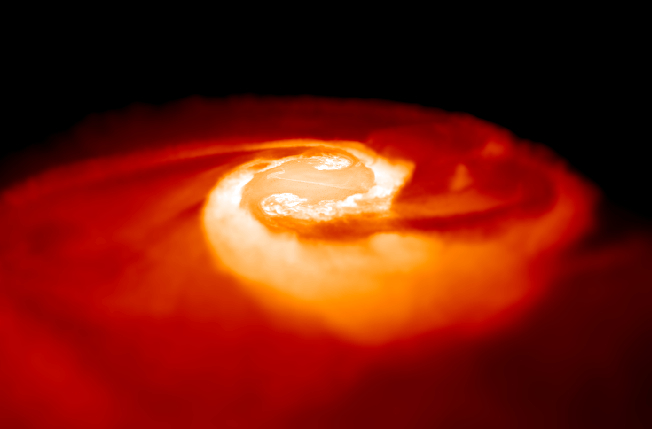
More central impact of two neutron stars with impact parameter β=2
|
Description:
Animation of a neutron star - neutron star grazing impact.
Parameters: m1= 1.3 M☉,
m1= 1.4 M☉, β=2.
This simulation is referred to as "run B" in Paper I (see Table 1).
Link to download the movie:
.mov
.mp4
|
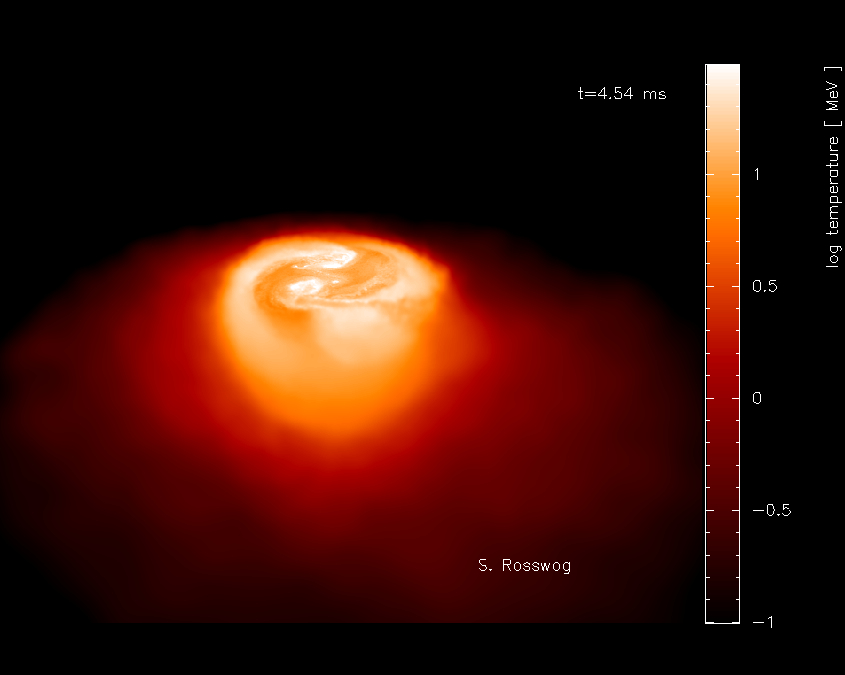
Very central impact of two neutron stars;
Impact parameter β=5
|
Description:
Neutron star - neutron star grazing impact.
Parameters: m1= 1.3 M☉, m1= 1.4 M☉, β=5.
This simulation is referred to as "run C" in Paper I (see Table 1).
Link to download the movie:
.mov (17 Mb)
|
Neutron star - black hole collisions
Here we only consider β=1-collisions and explore the dependence on the black hole mass.
All neutron stars have 1.3 solar masses.
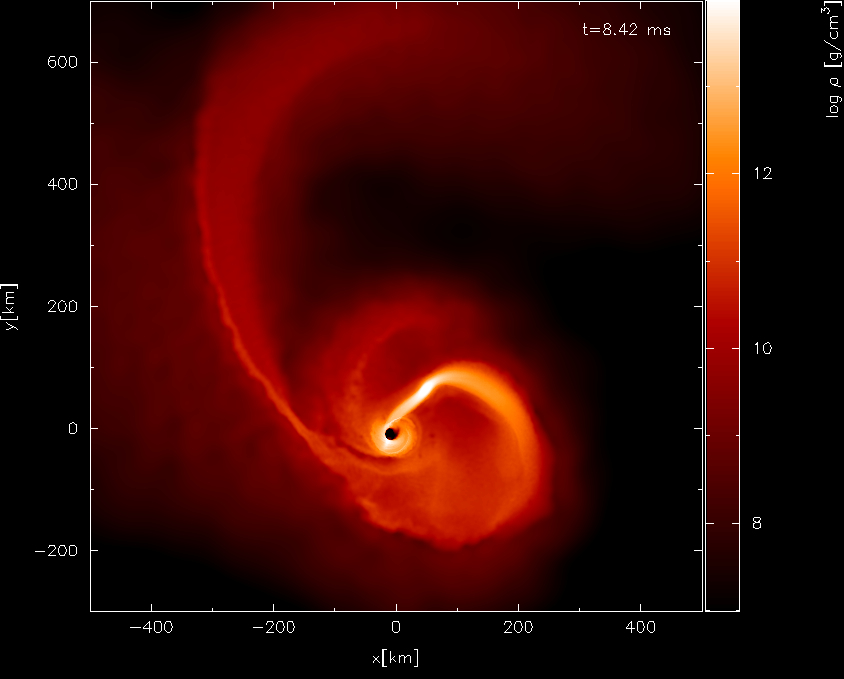
Neutron star - black hole collision; black hole mass mbh=3M☉.
The movie visualizes density cuts in the initial orbital plane (XY).
|
Description:
Neutron star - black hole collision.
Parameters:
mns = 1.3 M☉,
β=1, and
mbh=3 M☉.
This simulations is referred to as "run D" in Paper I, see Table 1).
Link to download the movie:
.mov (5.8 Mb)
|
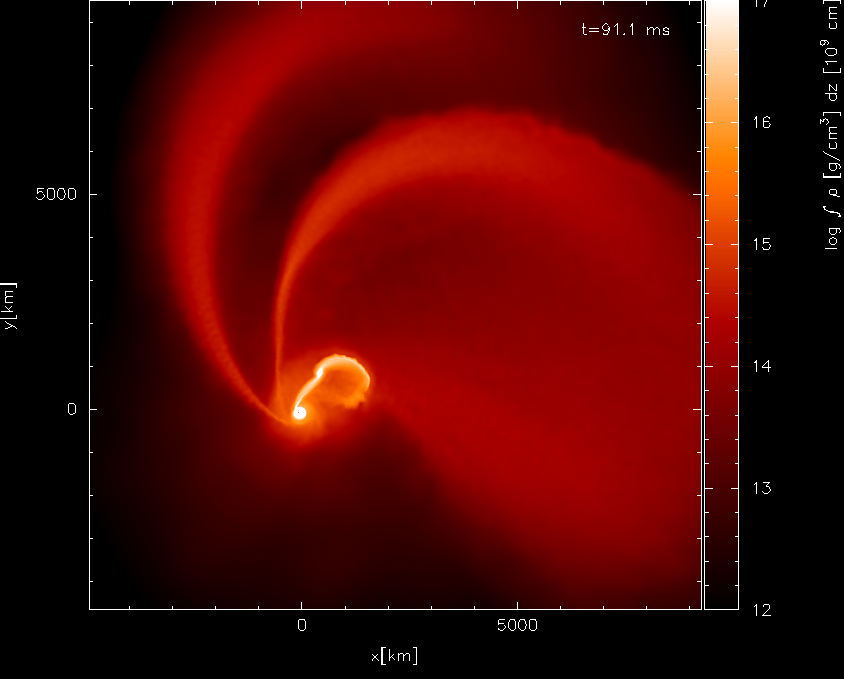
Neutron star - black hole collision; black hole mass mbh=5M☉
(column density).
|
Description:
Neutron star - black hole collision.
Parameters:
mns = 1.3 M☉,
β=1, and
mbh=5 M☉.
This simulations is referred to as "run E" in Paper I, see Table 1).
Link to download the movie:
.mov (47 Mb)
|
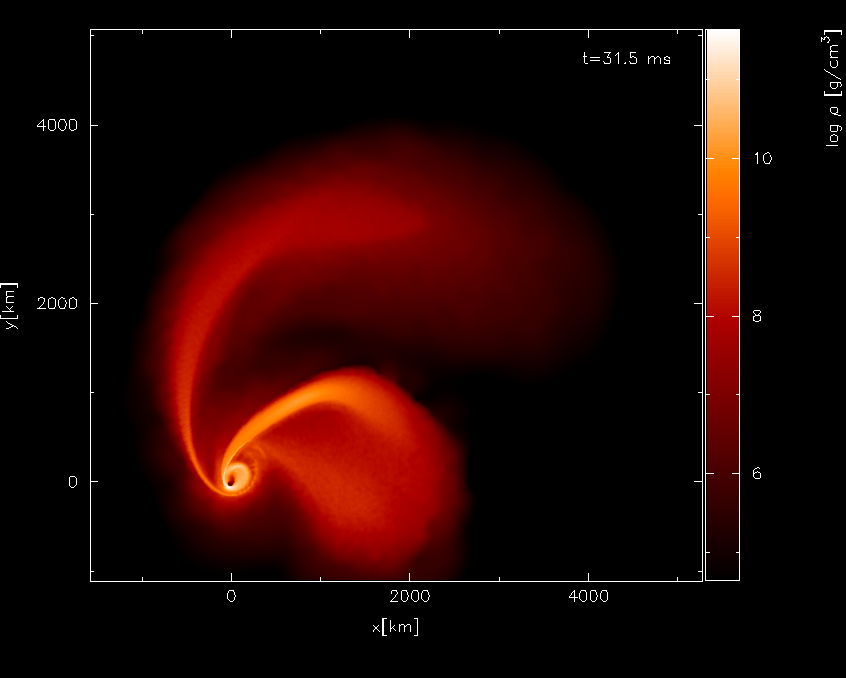
Neutron star - black hole collision with the black hole mass mbh=10M☉
(density cut in the orbital plane).
|
Description:
Neutron star - black hole collision.
Parameters:
mns = 1.3 M☉,
β=1, and
mbh=10 M☉.
This simulations is referred to as "run F" in Paper I, see Table 1).
At late times, the output frequency of the simulation was reduced, so the movie runs faster.
Link to download the movie:
.mov (5 Mb)
|
Tidal disruptions
Accretion of white dwarf debris onto black hole: X-ray flares

Tidal disruption of white dwarf and accretion of debris onto the black hole: visualization of the column density
|
Description:
This animation shows the column density of a white dwarf which is being tidally
disrupted by an intermediate-mass black hole
(Mbh=1000M☉).
- about 30% of the white dwarf are accreted by the black hole
- on returning to the black hole, the debris forms a "nozzle" and an "accretion fan"
- when matter that has passed the hole interacts with still infalling matter an angular momentum re-distribution shock forms
Link to download the movie:
.mov
|
Conclusion
- tidal disruptions of white dwarfs can induce thermonuclear explosions via tidal compression;
- IF intermediate-mass black holes do exist, upcoming supernova surveys such as
LSST should detect these peculiar thermonuclear supernovae;
- These explosions g along with a soft X-ray flare of several months duration.
References
r-Process nucleosynthesis
This movie demonstrates the r-process, that happens in the dynamical ejecta
from neutron star - neutron star and neutron star - black hole encounters.
For details, see the paper:
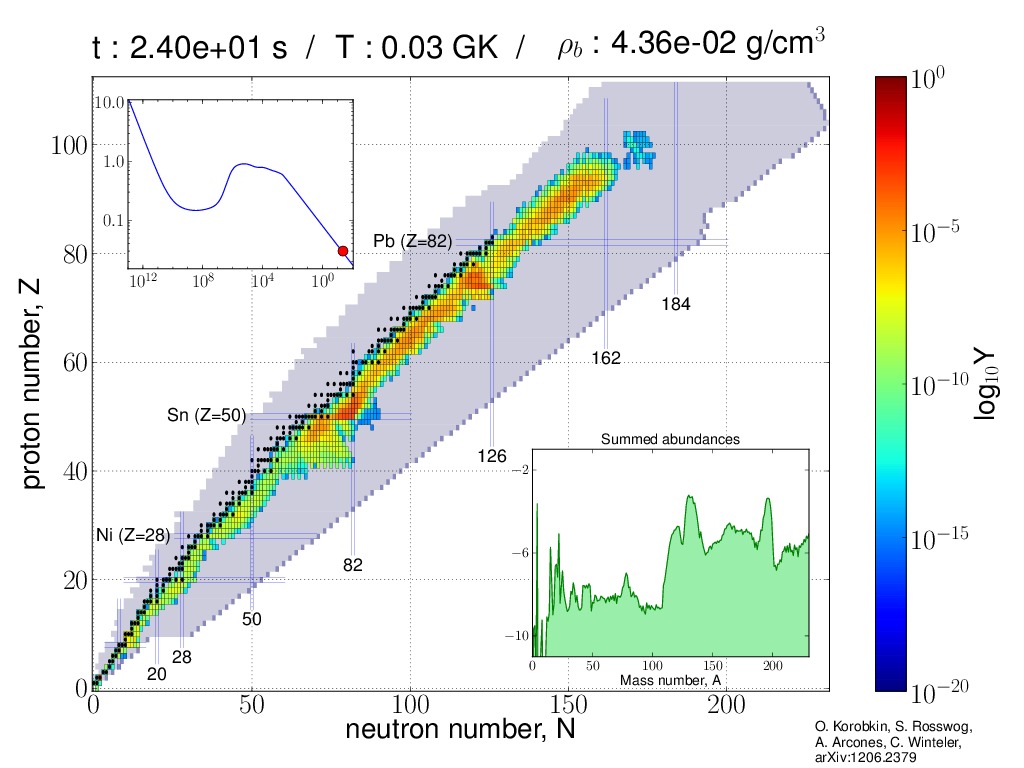
Nucleosynthesis in r-process
|
Description:
This movie demonstrates nucleosynthesis of heavy elements in neutron-rich
ejecta from ns/bh encounters. The axis represent proton and neutron numbers,
and each cell is color-coded depending on the abundance of a particular isotope.
Insets demonstrate the dynamics of the integrated abundances and the evolution of
thermodynamic parameters in the ejected matter.
Download the r-process movie:
.avi
.mov
|
Accretions disks
Thick massive accretion disks around black holes which form shortly after
stellar collapse or a merger of two neutron stars are thought to power central
engines of gamma-ray bursts (GRBs). Under certain conditions, they can undergo catastrophic
runaway accretion, in which large portion of the disk is swallowed by a black
hole on a timescale of milliseconds. This can have dramatic
influence on the jet and consequently on the resulting GRB.
This movie visualizes computer simulation a disk-black hole
system which undergoes the runaway instability.
For this simulation, we used multi-patch spacetime metric solver based on
Cactus / Carpet
computational infrastructure. For more details, see the following paper:

General relativistic runaway
instability in accretion disk
around a black hole
|
Description:
This movie shows the rendering of the accretion disk density in logarithmic
scale, with the black hole apparent horizon represented by an ellipsoid in the
middle.
Part of the disk ( π/4-slice) is cut out to show the density
distribution more clearly.
The density is normalized to its maximum value at t = 0.
Created with VisIt
visualization software.
Download the runaway instability movie:
.avi
.mov
|
|